The tourniquet is the rock-star in the world of medical devices. Tourniquets are the latest in an ever-growing list of strongly-encouraged EDC items. If I had my ‘druthers I would always have a full medical kit at hand. That’s not always possible, so if I had to limit myself to a single medical device, I’d choose the most versatile single item. Instead of a tourniquet, I’d choose the multi-tool of medical stuff: the triangular bandage. I know that’s a controversial position, so let me explain.
This article contains NO affiliate links. All product links contained in this article are directly to OEM websites or reputable dealers like NA Rescue and Chinook Medical, with which I have no affiliation.
Medical Disclaimer: Nothing in this article should be construed as medical advice. I’m just telling you what I do, not what you should do. This article is not intended as a substitute for professional, high-fidelity training; YOU SHOULD SEEK COMPETENT MEDICAL TRAINING and operate within your scope of practice.
The Tourniquet Talisman
I feel like there is a lot of emotion wrapped up in the modern, commercial tourniquet. It’s gone from the “last resort” tool of my youth to the (perceived) “only thing you need” medically, for EDC. People seem so emotional about the tourniquet I feel compelled to explain why it’s not my go-to medical tool.
To be clear, the modern, commercial tourniquet is awesome at what it does. It does what it does way better than an improvised tourniquet all day long. Unfortunately, it only does one thing: stop uncontrolled hemorrhage from the extremities. That’s it.
Notice there’s that “uncontrolled” qualifier, so it’s not even a universal intervention for extremity bleeds. And it doesn’t even pretend to be useful for any type of injury to the head, neck, or the bulk of the human body: the torso. Tourniquets are often seen as the medical talisman, not as the incredibly specific tool that they actually are. The list of life-saving stuff a tourniquet won’t do for you is a long one.
If you carry a tourniquet I’m not telling you that should change, but on-body carry of a tourniquet and nothing else isn’t for me. Quality, CoTCCC-recommended tourniquets (the only ones I’d carry or recommend, by the way – the CAT, RMT-T, SAM-XT, SOFTT-W, TMT, and TX2/TX3) are wide, bulky, and have a windlass. They take up a lot of space in a pocket, or require a belt pouch or ankle rig of some sort. Tourniquets take up a lot of space. In return they don’t provide a broad capability.
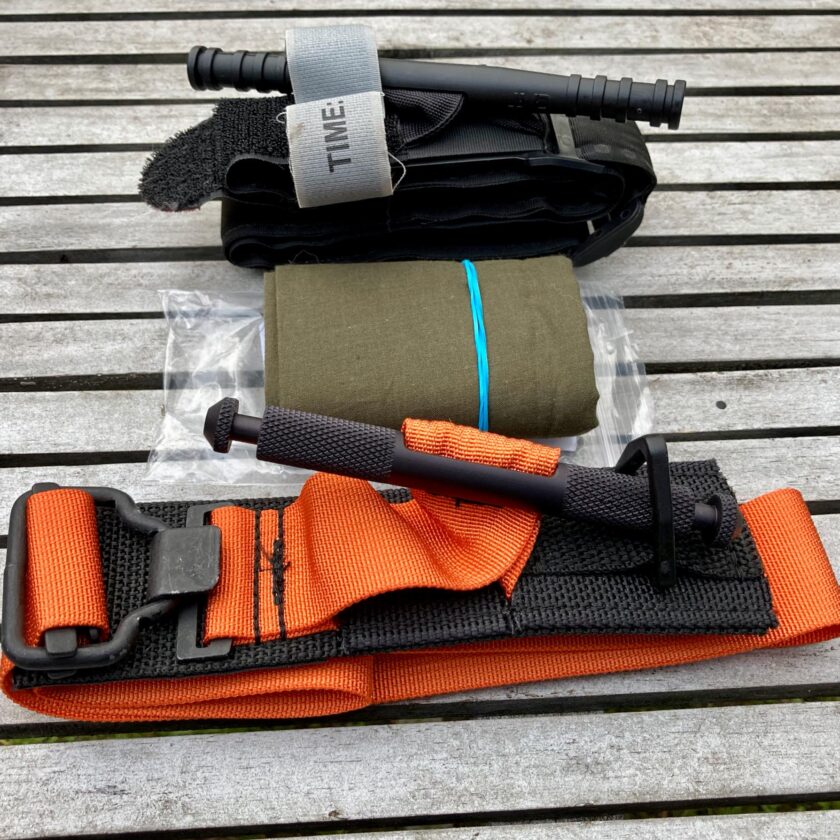
Again, before you get mad at me, I’m not saying you’re wrong for carrying a tourniquet. I always have some at home, one in my car, and one in the IFAK in my EDC bag. They are fantastic tools when indicated. But realize if you are carrying one, it’s a lot like carrying a ratchet with a 13/16th” socket: it’s the perfect tool for one narrow scenario, but it’s just about useless in any other.
For that reason it’s not the intervention I’m going to carry if I can’t carry a fully-stocked kit. Instead, I’ve equipped my space-limited, minimalist survival kit with they lowly, boring triangular bandage. I’m even playing with carrying a triangular bandage on my person, day-to-day.
Let’s talk about the triangular bandage. This should make my reasoning for choosing it over a tourniquet in a survival context apparent. It should also make my decision to carry it on a daily basis instead of a tourniquet at least understandable.
The Correct Right Triangular Bandage
The triangular bandage has been around for a very long time – eons before the commercial tourniquet. It’s also called a “cravat” and is nothing more than a triangular piece of cloth cut into a right triangle. The strengths of the triangular bandage are simplicity and versatility. To the former, you can make your own from scrap material if you are on a strict budget. To the latter, the triangular bandage can be used for all sorts of purposes, medical and otherwise.
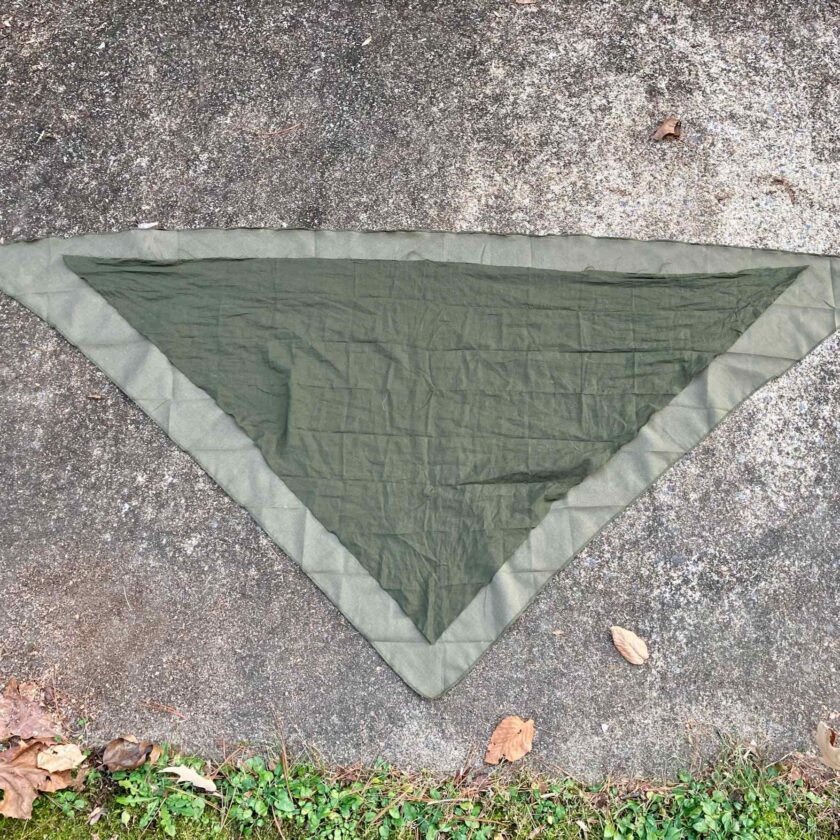
Most of us are going to go out and buy one, however. Since the triangular bandage is nothing more than a triangular strip of cloth, a lot of companies make them. This is an item where you get what you pay for. Sometimes they’re a very loose weave cotton and sometimes they are a sturdy, tight weave. Sizes vary, but most are between 36″ x 36″ x 51″ on the low end, up to 40″ x 40″ x 56″ on the higher end.
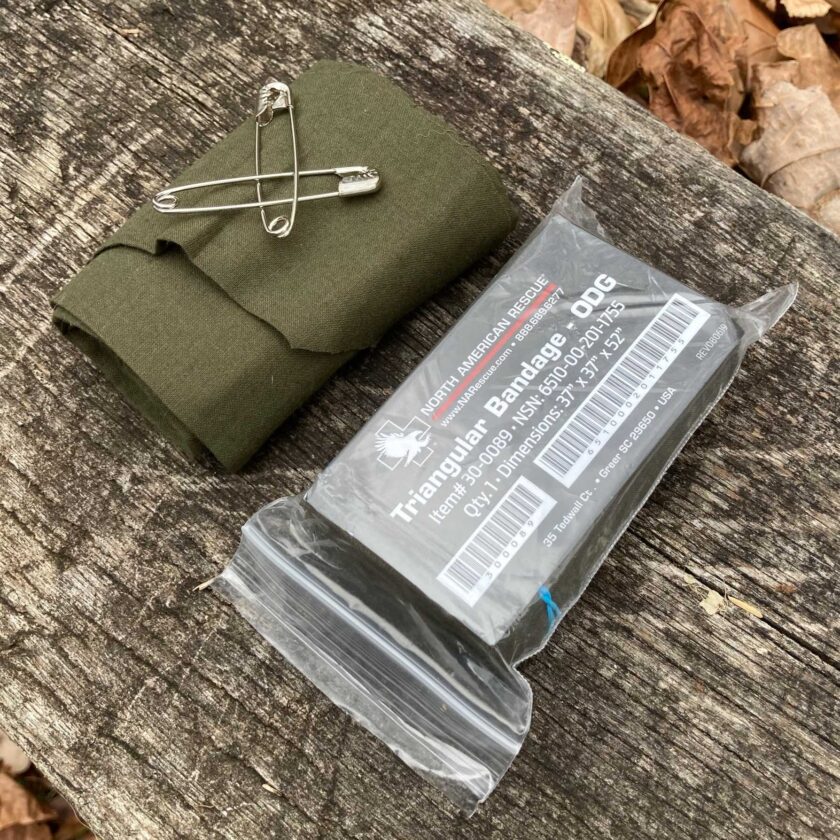
Some are quite a bit larger, like the “Cravat Triangular Bandage” from ChinookMed at 46″ x 46″ x 65″. Almost all are packaged with two large safety pins. I happen to really like the big Chinook Med cravat, for several reasons.
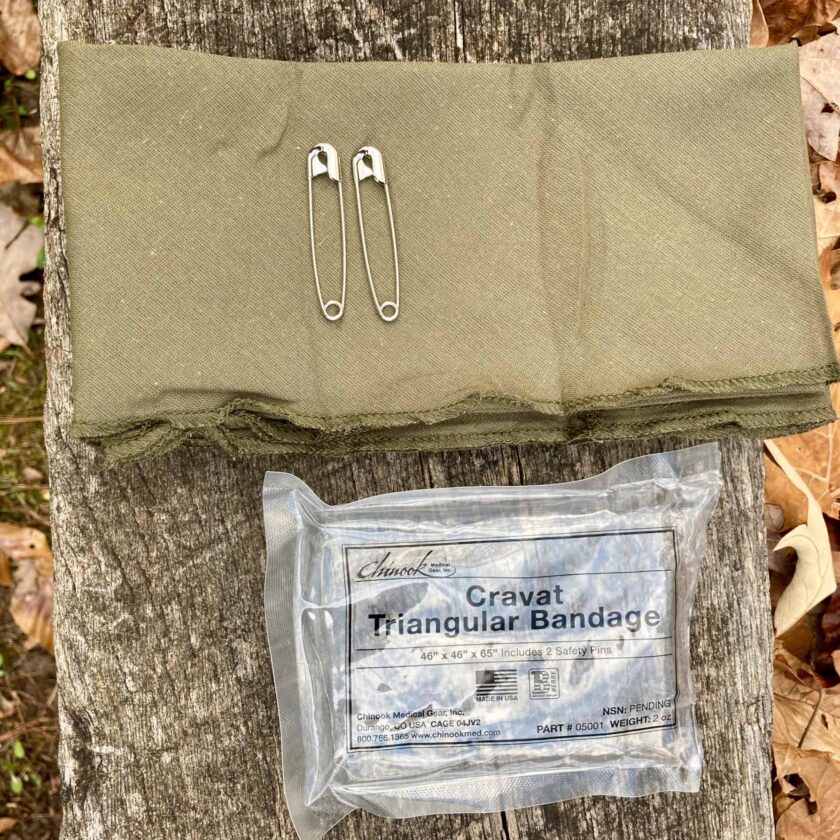
First, more material equals more opportunity to make the bandage work for you. It’s the largest one of the bunch. Second, it’s made out of the best material. Instead of the very cheap, loosely woven fabric cravats found in your break-room’s first aid kit, this has a nice, tight weave. The edges are also hemmed making it more durable for use and reuse (reusing medical devices generally isn’t recommended but we might in a survival context).
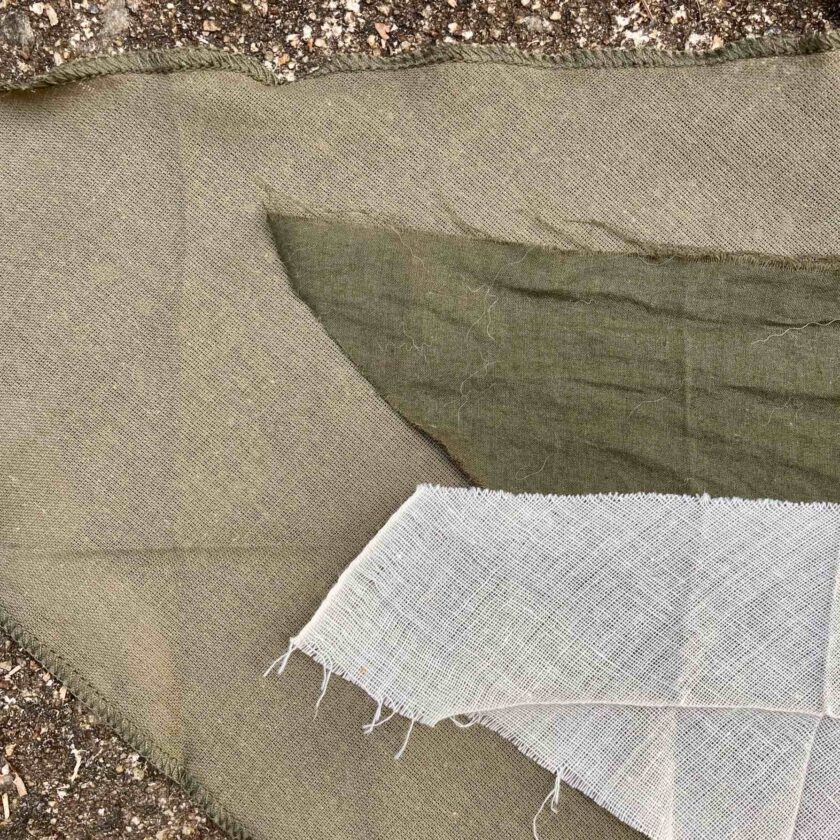
One of my favorite features of the Chinook model is the way it is packaged. It is vacuum packed into a thick, plastic sleeve. For day-to-day carry this helps protect it from sweat, grit, sawdust (just me?), and the other detritus that finds its way into pockets. In a survival situation it also gives the bandage an excellent chance of being dry when you need it.
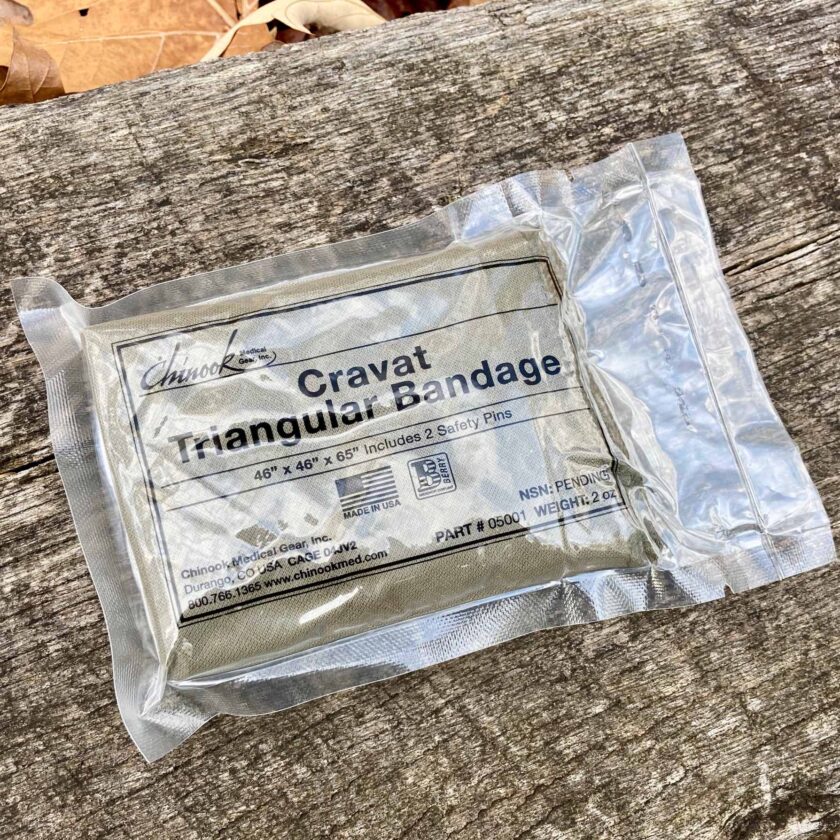
The packaging is scored and tears open easily. The factory fold is nice and wide, making this a much flatter than competing options, which is important to me for back-pocket carry. Despite being bigger, it feels smaller. The thick plastic wrapper and flat form-factor also make this idea for the storage of a little Gorilla Tape, which makes this even more versatile and potentially useful…but I’ll get there in a minute. The Chinook Med cravat is only $7. I think you should have several around at all times. Let’s take a look at some of the stuff you can do with it. But first…
A Little Disclaimer
When you carry a multi-tool you acknowledge that you are making a compromise. No tool on the multi-tool is as good as a full-sized, dedicated version of that tool. But many of us carry multi-tools because they allow us to do a lot of things, well enough. This is also factored with likelihood of need; if we know we’re going to need a a file or a screwdriver, we try to bring a real file or screwdriver. But most days, when we could may face any of dozens of situations with none presenting as inordinately likely, we carry a multi-tool.
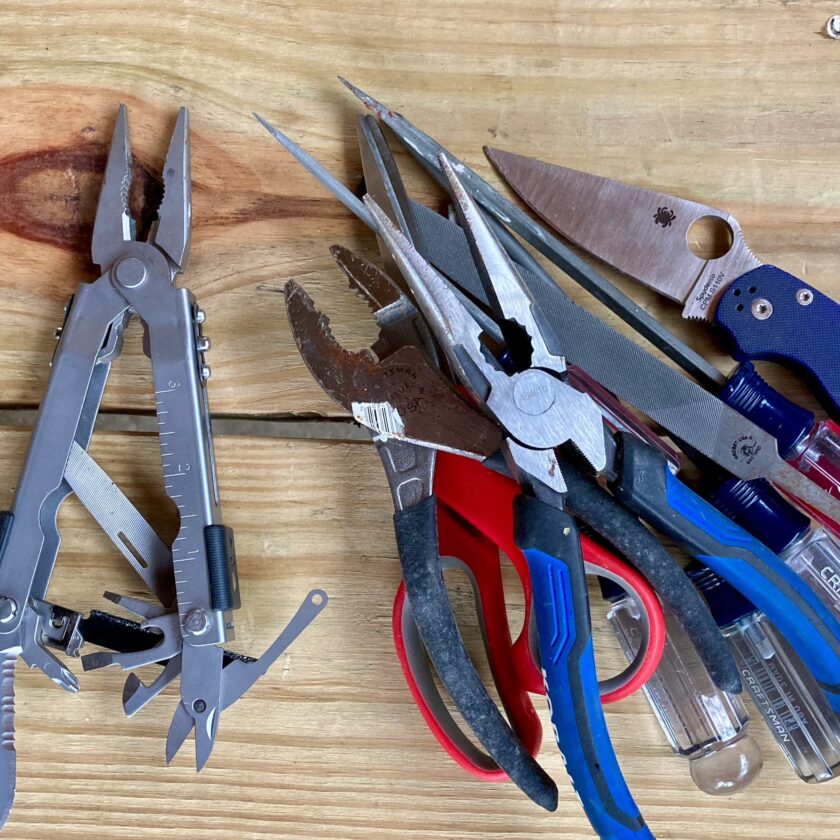
That’s kind of the deal with the medical multi-tool, too. It doesn’t work as well as a tourniquet, it’s not quite as good at wound-packing as softer, more absorbent roller gauze, and it’s not as good a sling as, well, a sling. Being a jack-of-all-trades it’s not perfect for anything, but it does a number of jobs reasonably well.
A lot of these compromises can be lessened through realistic practice. You can become faster and better at employment, but you’re still working with an improvised tool – not the best possible tool for the job. Keep that in mind and be realistic about what you’re gaining…and giving up.
Now let us look at some of the things that can be done with a triangular bandage.
Triangular Bandage: Improvised Tourniquet
Yes, you can improvise a tourniquet, and the best possible improvised tourniquets are made with a triangular bandage. I’m not going to explain how to make an improvised tourniquet in this article (instead I recommend checking out this article and this video). I am going to offer a few caveats, though.
First, this won’t be as good as a commercial tourniquet – it just won’t. It will be harder to place, take longer to put assemble to effectiveness, and it may not occlude arteries as well. In studies improvised tourniquets have a pretty dismal record. Sometimes these studies represent less-than-ideal materials (like belts and surgical tubing) and sub-optimal technique. Still, after a lot of practice I’ll be the first tell you that a triangular bandage might work as a tourniquet, but it sucks compared to a commercial TQ.
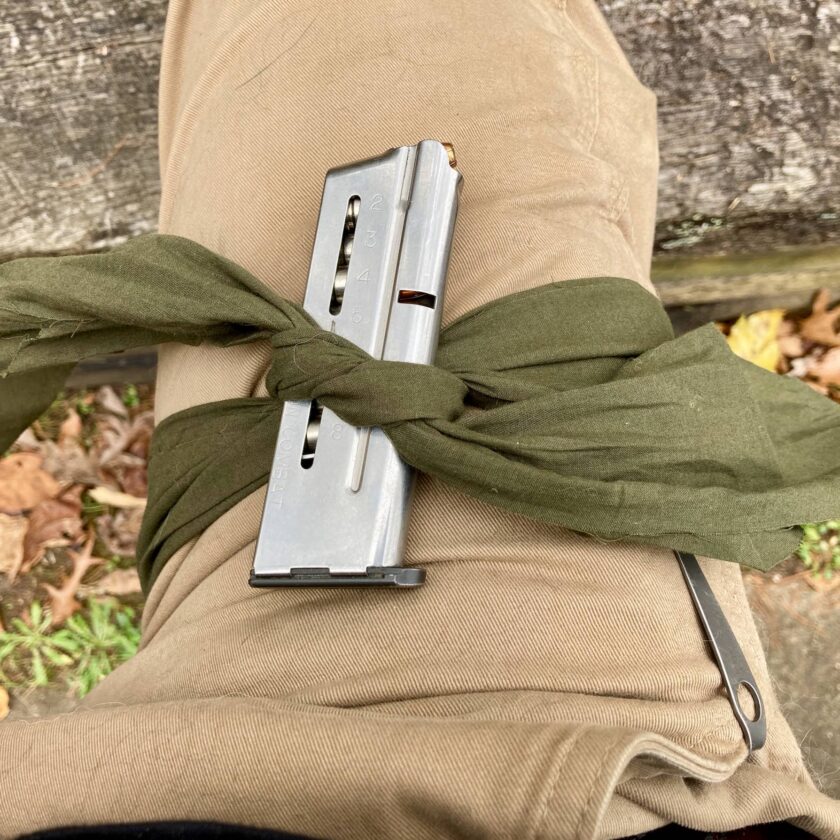
But, I’m more likely to have it on my body than a tourniquet, so I attempt to maximally mitigate some of the shortcomings of the triangular bandage through practice. Practice, practice, practice. Practice will help you understand exactly what you have to do to retrieve your tools and for that matter, what tools you need. Practice will help you get fast at putting a tourniquet together, and it will give your improvised tourniquet the best possible chances of success. Practice until you can put a tourniquet on your own right arm, blindfolded. PRACTICE!
I have a couple more pointers that can’t be stressed too much. First, you need a nice, strong windlass that won’t break. You can improvise one pretty easily, but you better do it quickly. Second, you need a way to secure the windlass. Otherwise it’s just going to spin until it’s completely loose and providing no vascular occlusion. Third, keep in mind that whatever you use as a windlass is now committed – you probably can’t switch it out later on, so choose wisely. If you’re in a gunfight a pistol magazine might not be your best option. Finally, your bandage needs to be nice and wide, and it needs to be applied very, very tightly. An improvised tourniquet is probably going to hurt, and hurt a lot more than a commercial tourniquet. Sucks, but from practice I can tell you it’s the truth.
Making a tourniquet isn’t where the triangular bandage shines. As I’ve said, it actually kind of sucks compared to a CAT or SOFTT-W. The beauty of the triangular bandage comes in with all the other stuff it does. Let’s take a look.
Triangular Bandage: Other Bleeding
Not all bleeding indicates a tourniquet. Not all extremity bleeding is severe enough to indicate at tourniquet, and not all bleeding happens on an extremity. It is still important to control bleeding, wherever it may occur. The triangular bandage allows you to manage various types of bleeding other than uncontrolled extremity hemorrhage.
Pressure Dressing: The triangular bandage will also work for simple bleeding that does not require a tourniquet. It can be used to hold simple, directly pressure (the FIRST resort when it comes to controlling bleeding). It can also be used to improvise a reasonably effective pressure dressing.
Wound Packing: the ubiquity of hemostatic agents in the Tactical Combat Casualty Care (TCCC) arena is due to the failure of tourniquets to treat vascular compromise in junctional areas. Junctional areas are “high femoral” and “high brachial” arteries, or the junctions between limbs and the torso. Tourniquets can’t get to those spots. Honestly they are pretty low-likelihood injuries, but they do occasionally occur.
In the absence of a hemostatic agent it is recommended that these wounds be deeply packed, followed by whatever pressure may be applied. The triangular bandage can be used to pack a profusely bleeding wound; as the Journal of Emergency Medical Services (JEMS) says, “completely and tightly pack the wound cavity to stop hemorrhage. Begin packing the gauze into the wound with your finger, while simultaneously maintaining pressure on the wound.” Per JEMS, wounds appropriate for packing include those in junctional areas, extremities, and the back. It is not recommended to pack wounds to the neck, chest, or abdomen.
The triangular bandage isn’t the absolute best choice for wound packing. It’s not as soft or as absorbent as gauze and it has no hemostatic properties. It can be torn into smaller pieces or strips to accommodate smaller wounds, or deep wounds with a narrow channel. Combined with strong, direct pressure it is a heck of a lot better than nothing.
Bleeding from the Head & Neck: The triangular bandage can also be applied in oddball locations like the head and neck. Again, this is where the extra size Chinook Medical cravat really comes in handy. It requires a bit of creativity (don’t just wrap this around one’s neck) but you can bandage just about any part of the body with a large triangular bandage.
Incidental Intervention: Occlusive Dressing
The large cravat from Chinook Medical also offers another possibility. I alluded to this earlier but the thick, plastic wrapper would make a really good occlusive dressing. Occlusive dressings are indicated in certain types of trauma. If there is penetrating trauma to the chest a three-sided occlusive dressing is indicated to allow air to escape the thorax but prevent it from entering. Occlusive dressings are also indicated in any kind of neck trauma where large amounts of air could enter large vessels like the jugular vein.
Having an occlusive dressing is pretty damn important to me. If someone is shooting at me in a civilian context I don’t expect them to be highly accurate. Criminals aren’t known for their precision marksmanship. However, the torso and neck combine to present a large, centrally located target area. I want something for that… and a tourniquet ain’t it.
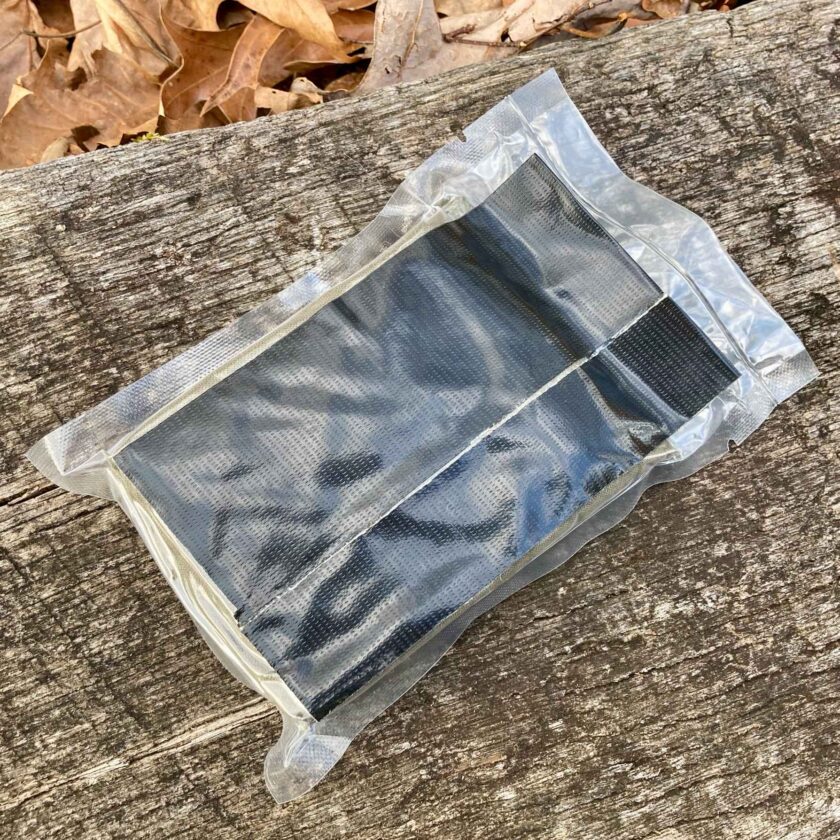
Unlike just about any other cravat packaging, the plastic wrapper that encloses the Chinook triangular bandage us nice and thick, and fairly large. It’s not a HyFin vent by any means, but it’s a heck of a lot bigger and more flexible than my library card. And here’s where the Chinook’s flat form factor really gets a gold star: it’s perfect for the application of some Gorilla Tape.
Why Gorilla Tape specifically? Because it’s insanely tough and incredibly sticky. On each side I placed a full- and a half-width strip of tape. I made sure to leave a “buddy tab” to make peeling the tape off easy. Again, this definitely isn’t as good as a HyFin Vent. But then again, if I knew I was going to need a HyFin Vent…I’d just stay home that day.
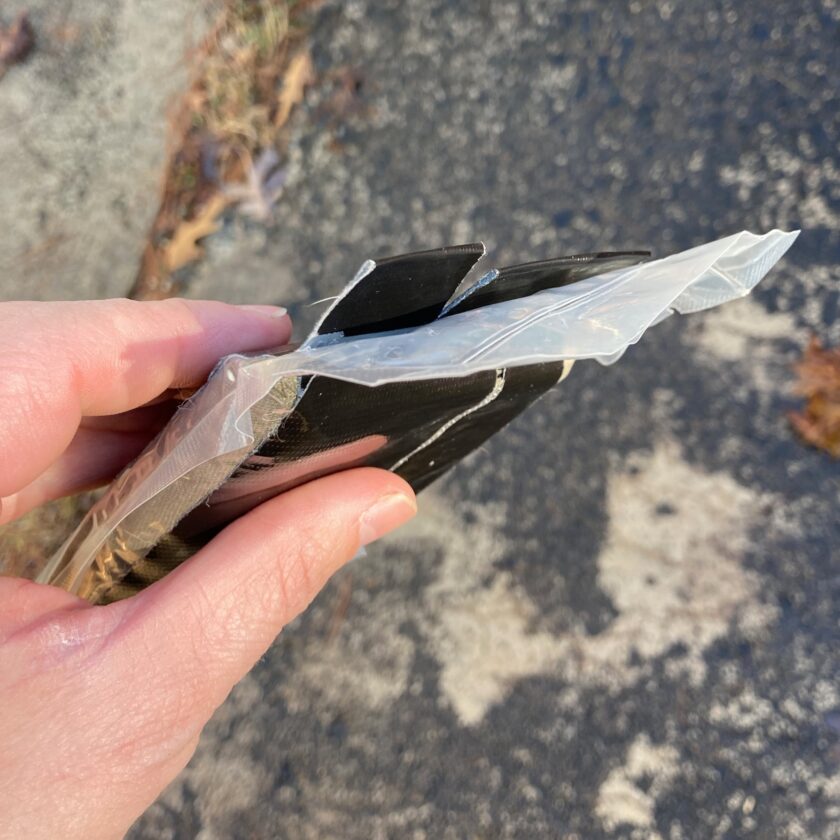
One other triangular bandage to keep your eye on is NAR’s “Dry Sterile Burn Dressing Cravat XL” – it’s large and has a tough, thick wrapper. It’s also packaged very wide and flat. It’s polyester and a bit tougher in some ways than cotton. Unfortunately these are currently back-ordered but I plan to review one as soon as I can get my hands on it (I called NA Rescue who said they should be available in Q1 this year).
Triangular Bandage: Orthopedic Uses
That pretty much covers the capability of the triangular bandage in the TCCC-type context. In a survival or non-gunfighting context the triangular bandage provides even more capability. Let’s look at orthopedic injuries. These aren’t going to be treated in the Care Under Fire (CUF, or “Indirect Threat Care/IDC” for you TECC types) phase of care but they do need to get treated, especially in a survival situation where you are your own medical support.
Sling: maybe the most common use of the triangular bandage in EMS is as a sling for dislocated shoulders and broken clavicles. It work marvelously well for this purpose, and I’m even put a couple of these on in my very short medical career.
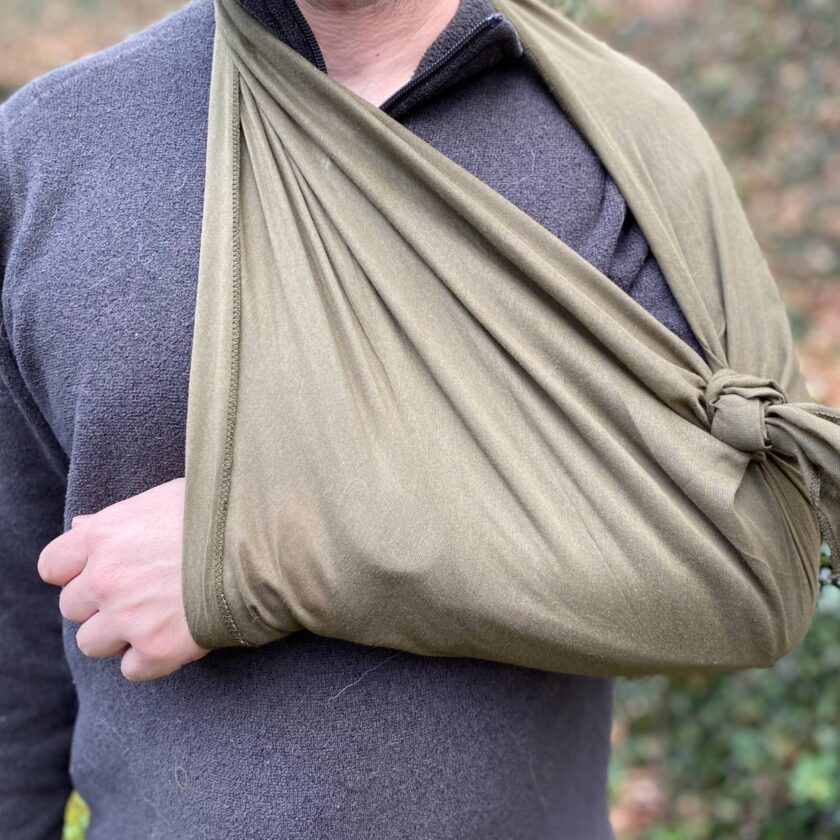
Pelvis binding: A broken pelvis is potentially a dire emergency. It is also incredibly painful. One thing that can increase the potential for an positive outcome and relieve some pain is binding the pelvis. In EMS we typically use a bedsheet for this but a large triangular bandage might also work (depending on the size of the individual). Here is where having a very large bandage comes in extremely handy.
Traction stirrup: Your triangular bandage can also be used as a stirrup to put around the foot to provide manual traction (or for an improvised traction splint). Traction can greatly relieve the pain and muscle spasm created by a femur fracture. Traction is only indicated for a closed, mid-shaft, simple fracture of the femur, but when its indicated you’ll want a way to provide it.
Other splinting needs: a triangular bandage is a pretty awesome piece of kit for splinting just about any injury. It can be used as a wide, flat binding to secure a rigid splint to a limb, to create a “pillow splint” around an ankle, or any number of other purposes.
Non-Medical Uses
Although the focus of this article is on medical uses of the triangular bandage, I do want to address some non-medical uses. Possible uses for this incredibly versatile tool are limited only by your imagination. Since I carry this tool in my survival kit(s), lets look at a few potential survival uses.
Head/neck cover: sunburn can be miserable and preventing it can be worth a pound of cure. A triangular bandage can be fashioned into all sorts of head and neck coverings that will protect you from sunburn.
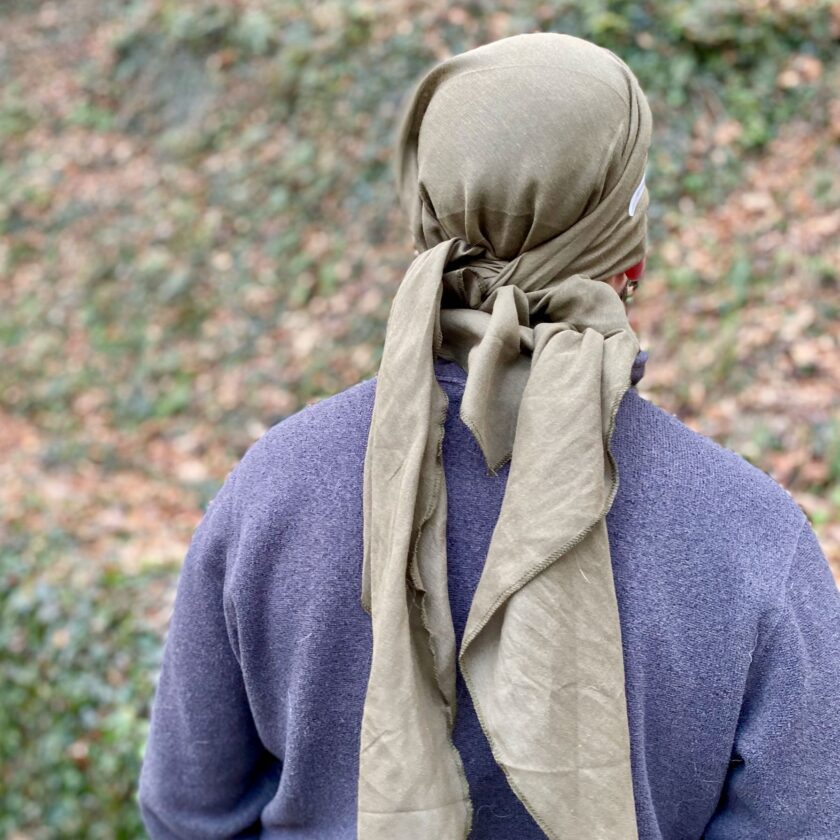
Water filter: filtering water through a triangular bandage (or any other single piece of cloth) will not remove pathogens from it. However, it will remove some sediment and other solids. This potentially makes water clearer, which not only makes it more palatable but also makes it easier to purify. Organisms (bacteria, protozoa, viruses) can travel on the bits of sediment in the water. The less sediment, the better things like water purification tablets and UV water purifiers work.
Face mask: yes, the triangular bandage can be a COVID face covering. It can also protect you from blowing dust (I’ve been in a major dust storm – not a fun time), and offer a little protection from smoke and dust in urban environments. It can also keep your face warm and protect it from sunburn. And speaking of sun…
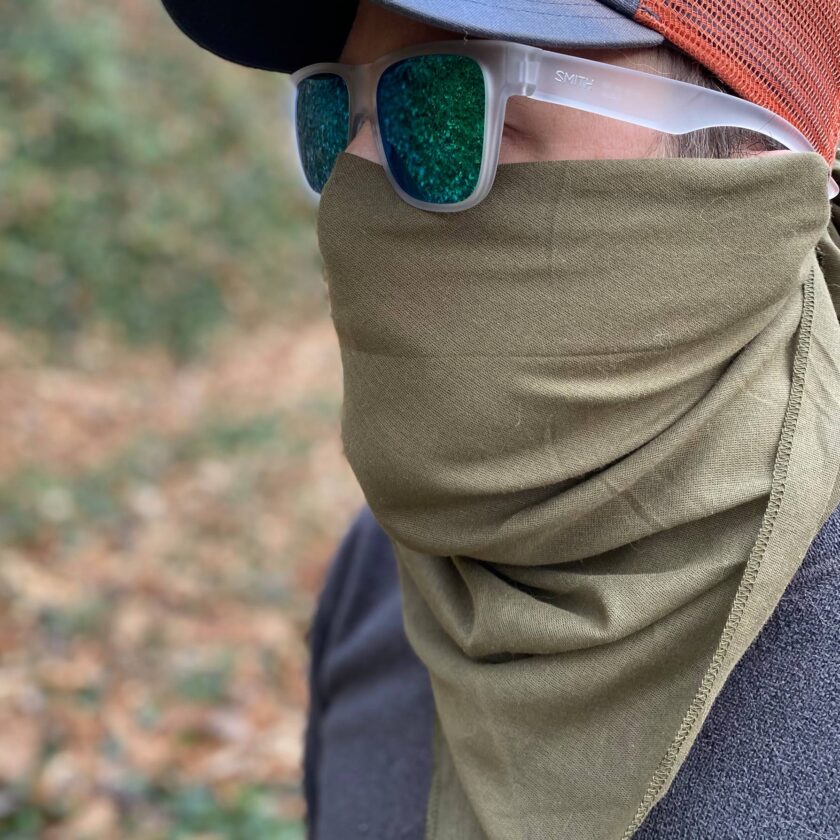
Sunglasses: a triangular bandage could be used as an improvised set of sunglasses. The weave is tight enough that it keeps a lot of sun out, but in bright conditions you can very much see through it. I wouldn’t recommend driving with a layer of bandage over your eyes – think snow-blindness or being stuck on a lake with light reflecting back up on you.
Warming/cooling: cotton isn’t a perfect insulator and the relatively thin weave of this bandage doesn’t help matters much. However, it could be added to your clothing to provide a bit more. It could be loosely coiled around your neck, or piled up on your head to preserve a bit more warm. While cotton isn’t ideal for the preservation of heat, it’s not worthless, especially if kept dry. Cotton’s downfall in cold weather makes it pretty decent at cooling you in hot weather. A wet cotton cloth helps transfer heat away from your body.
Um, “other” uses: as I discovered on a hike Saturday, a triangular bandage makes a good, ahem, personal towelette. Nature called, and in a way that demanded a stronger answer than leaves. I tore a strip of inexpensive bandage for a tough cloth suitable for one’s sensitive areas. I wouldn’t do that in a survival situation where resources were limited but on a hike that was nearing it’s end I was glad to have them.
Closing Thoughts
Once again I want to make clear: the triangular bandage isn’t the only medical intervention I own. It’s not the only one I keep handy. It’s not the only one I recommend. Generally I’m for having the right tool for the right job. Sometimes a multi-tool is indicated, however, and my minimal survival kit is a great example – I have about enough room for one tool.
If you’re looking for a medical multi-tool the triangular bandage is it. It can be used to control various types of bleeding – to apply direct pressure, to pack wounds, and as an improvised tourniquet. It can be used for splinting and immobilizing fractured bones. The triangular bandage is also an asset in various other ways – as a big ol’ piece of cloth it can serve a multitude of purposes.
If you have room for a whole like, carry a whole kit. If, however, you’re looking for THE tool when you only have room for A tool, revisit the boring old triangular bandage. It brings a whole lot to the table.





